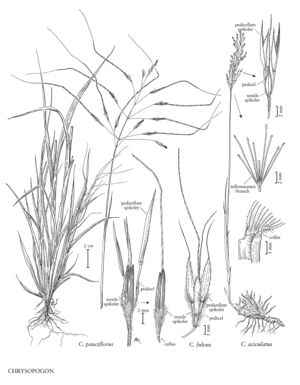Difference between revisions of "Chrysopogon aciculatus"
FNA>Volume Importer |
imported>Volume Importer |
||
| (8 intermediate revisions by 2 users not shown) | |||
| Line 17: | Line 17: | ||
-->{{Treatment/Body | -->{{Treatment/Body | ||
|distribution=Pacific Islands (Hawaii);Fla. | |distribution=Pacific Islands (Hawaii);Fla. | ||
| − | |discussion=<p>Chrysopogon aciculatus is native to tropical Asia, Australia, and Polynesia. In the contiguous United States, it is known only from controlled plantings at the experiment station in Gainesville, Florida. It is a vigorous colonizer of bare ground that can withstand heavy grazing and trampling, and is difficult to eradicate once established. The sharp calluses are injurious to grazing animals. The U.S. Department of Agriculture considers C. aciculatus a noxious weed, and should be informed if the species is found growing in other than a controlled planting.</p> | + | |discussion=<p><i>Chrysopogon aciculatus</i> is native to tropical Asia, Australia, and Polynesia. In the contiguous United States, it is known only from controlled plantings at the experiment station in Gainesville, Florida. It is a vigorous colonizer of bare ground that can withstand heavy grazing and trampling, and is difficult to eradicate once established. The sharp calluses are injurious to grazing animals. The U.S. Department of Agriculture considers <i>C. aciculatus</i> a noxious weed, and should be informed if the species is found growing in other than a controlled planting.</p> |
|tables= | |tables= | ||
|references= | |references= | ||
| Line 26: | Line 26: | ||
-->{{#Taxon: | -->{{#Taxon: | ||
name=Chrysopogon aciculatus | name=Chrysopogon aciculatus | ||
| − | |||
|authority=(Retz.) Trin. | |authority=(Retz.) Trin. | ||
|rank=species | |rank=species | ||
| Line 33: | Line 32: | ||
|basionyms= | |basionyms= | ||
|family=Poaceae | |family=Poaceae | ||
| + | |illustrator=Linda A. Vorobik;Annaliese Miller | ||
| + | |illustration copyright=Utah State University | ||
|distribution=Pacific Islands (Hawaii);Fla. | |distribution=Pacific Islands (Hawaii);Fla. | ||
|reference=None | |reference=None | ||
| Line 38: | Line 39: | ||
|publication year= | |publication year= | ||
|special status= | |special status= | ||
| − | |source xml=https:// | + | |source xml=https://bitbucket.org/aafc-mbb/fna-data-curation/src/200273ad09963decb8fc72550212de541d86569d/coarse_grained_fna_xml/V25/V25_1542.xml |
|subfamily=Poaceae subfam. Panicoideae | |subfamily=Poaceae subfam. Panicoideae | ||
|tribe=Poaceae tribe Andropogoneae | |tribe=Poaceae tribe Andropogoneae | ||
Latest revision as of 17:57, 11 May 2021
Plants perennial; extensively stoloniferous, with numerous sterile, leafy shoots. Culms 15-50 cm, often decumbent at the base, otherwise ascending or erect. Sheaths entirely or mostly glabrous, sometimes ciliate on the upper margins; ligules 0.1-0.3 mm, membranous, ciliolate; blades 1.5-11(23) cm long, 3-7 mm wide, adaxial surfaces mostly glabrous, or with a few papillose-based hairs near the base. Panicles 3-10 cm long, 1-3 cm wide, with many branches; branches 1.5-3.5 cm, stiffly ascending or appressed, naked lower portions 1.3-2 cm, terminating in a rame; rames 5-15 mm, with 1(-4) spikelet pairs. Sessile spikelets 7.5-9 mm (including the callus); calluses 3-6.4 mm, sharp, setose, hairs 0.4-1.1 mm, golden; lower glumes smooth on the lower portion, scabrous distally, acute or shortly bilobed; upper glumes mucronate, mucros 0.5-1.3 mm; upper lemmas awned, awns 4-8 mm, exerted, more or less straight. Pedicels 2-4 mm, mostly glabrous, hispidulous distally. Pedicellate spikelets 4.4-7.1 mm, staminate; glumes acute to acuminate; anthers 1.5-2.7 mm. 2n = 20.
Distribution
Pacific Islands (Hawaii), Fla.
Discussion
Chrysopogon aciculatus is native to tropical Asia, Australia, and Polynesia. In the contiguous United States, it is known only from controlled plantings at the experiment station in Gainesville, Florida. It is a vigorous colonizer of bare ground that can withstand heavy grazing and trampling, and is difficult to eradicate once established. The sharp calluses are injurious to grazing animals. The U.S. Department of Agriculture considers C. aciculatus a noxious weed, and should be informed if the species is found growing in other than a controlled planting.
Selected References
None.
